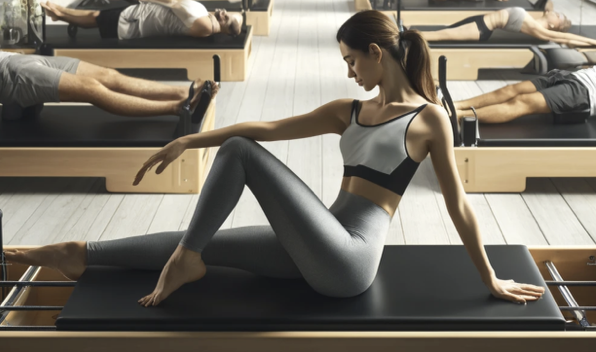Integrate Pilates for Flexibility and Core Strength
A Sculpting Solution (In-Depth)
5/10/20243 min read


3. Building Strength Throughout Your Body: A Balanced Approach
While Pilates focuses on core strength, it doesn't neglect other muscle groups. Many Pilates exercises engage your entire body in a coordinated manner, promoting balanced strength development:
Functional Strength Training: Pilates exercises often mimic everyday movements, building functional strength that translates to activities outside the studio. For instance, exercises like lunges and squats with proper form strengthen your legs and core, improving your ability to climb stairs, walk, or lift groceries.
Full-Body Conditioning: From your arms and shoulders to your legs and glutes, various Pilates exercises work different muscle groups, leading to a more sculpted and toned physique. Exercises like arm circles with light weights or resistance bands strengthen your shoulders, while push-up variations (modified on knees for beginners) work your chest, triceps, and core.
4. Improved Balance and Coordination: Sharper Movement
Pilates exercises often challenge your balance and coordination. Maintaining proper form while performing controlled movements on a mat or reformer (a specialized Pilates equipment) requires focus and body awareness:
Proprioception Power: Pilates strengthens your proprioception, your body's sense of position and movement in space. Exercises like single-leg balances or standing Pilates variations challenge your ability to maintain stability on one leg, improving your balance and reducing the risk of falls.
Mind-Body Connection: A core tenet of Pilates is the mind-body connection. Focusing on your breath and proper form during each exercise strengthens the link between your mind and muscles, leading to more controlled and coordinated movements. For instance, Pilates breathing techniques help you engage your core muscles during exercises, maximizing their effectiveness.
Ready to Experience the Transformative Power of Pilates?
Pilates offers a unique approach to fitness, combining flexibility, core strength, balance training, and a focus on mindful movement. Whether you're a seasoned athlete seeking to enhance your performance or a fitness beginner looking to improve your overall well-being, Pilates can be adapted to your individual needs and fitness level.
Unlock Your Potential with Our Free Weekly Newsletter!
Sign up below and get your FREE Ebook " The HIIT Revolution”
Take charge of your fitness and unlock the transformative power of Pilates! Join our thriving Pilates community and empower yourself with the knowledge and resources to achieve a stronger, more flexible, and balanced you.
Looking to transform your body with a low-impact yet highly effective exercise method? Look no further than Pilates! Often dubbed the "thinking person's exercise," Pilates offers a unique blend of controlled movements that target your core, improve flexibility, and enhance overall balance. Here's a deep dive into how Pilates can benefit your fitness journey.
1. Building a Powerful Core: The Engine of Your Body
Your core muscles – encompassing your abdominals, lower back, and hips – act as your body's powerhouse. A strong core provides stability and support for your spine, improves posture, and reduces the risk of back pain. Unlike traditional crunches that isolate just the "six-pack" muscles, Pilates targets these core muscles in a holistic way:
Activation from the Inside Out: Pilates emphasizes controlled movements with proper form, engaging not just the superficial "six-pack" muscles, but also the deeper stabilizing muscles like the transverse abdominis. This deeper core activation creates a strong foundation for your entire body.
Variety is Key: Pilates offers a diverse repertoire of exercises that target different core muscle groups.
Here are some examples:
Planks: These exercises engage your entire core, from your transverse abdominis to your glutes and shoulders, promoting isometric strength (holding a position against resistance). Variations like side planks and high planks challenge your obliques and improve core stability.
Bridges: Bridge variations like single-leg bridges and glute bridges work your core muscles while strengthening your glutes and hamstrings. These exercises improve core-to-lower body connection and overall stability.
Leg Circles and Abdominal Curls: These exercises challenge your core in different ways. Leg circles performed with control activate your deep core stabilizers, while abdominal curls with proper form target your rectus abdominis (six-pack) muscles.
2. Enhanced Flexibility for Effortless Movement
Tight muscles can hinder your athletic performance and limit your range of motion in everyday activities. Pilates incorporates gentle stretches and dynamic movements that progressively lengthen and loosen your muscles, leading to increased flexibility:
Mindful Stretching: Unlike static stretching, which can sometimes lead to injury if done incorrectly, Pilates emphasizes mindful stretches that gradually increase your range of motion. These stretches are often integrated into the flow of exercises, ensuring your muscles are warm and ready for deeper stretches.
Specificity Matters: Pilates stretches target specific muscle groups that tend to get tight, such as your hamstrings, hip flexors, and shoulders. For instance, hamstring stretches like hamstring slides or seated pike variations help lengthen the backs of your legs, improving your ability to bend forward with a flat back.
Increased Mobility for Daily Life: Improved flexibility translates to better mobility in your daily activities. Whether it's reaching for something on a high shelf, tying your shoes, or twisting your torso to check your blind spot while driving, Pilates can help you move with greater ease and confidence.
